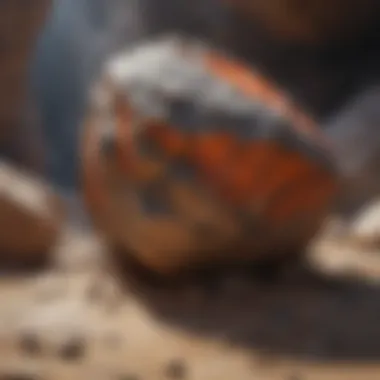Unveiling the Cutting-Edge World of Rock Scanning: A Comprehensive Guide


Rock and Fossil Identification
Rock and fossil identification is a fundamental aspect of the captivating world of rock scanning. Enthusiasts delve into various types of rocks and fossils, each with its unique characteristics waiting to be uncovered. From igneous to sedimentary rocks, the diversity of specimens is endless. Fossils hold valuable clues from the past, allowing collectors to journey through time as they explore ancient remnants. To aid in precise identification, enthusiasts utilize a range of tools such as magnifying glasses, geologic hammers, and UV lights to help distinguish key features.
Collecting Tips and Techniques
Embarking on a successful collecting expedition requires a blend of expertise and careful planning. Aspiring collectors are guided on best practices, emphasizing the importance of respecting natural surroundings and adhering to ethical standards. Locating prime collecting sites involves meticulous research and networking with experienced individuals to uncover hidden gems. To safely extract specimens without causing harm to the environment or jeopardizing the integrity of the find, collectors employ gentle techniques and specialized tools, ensuring that each discovery is handled with care and precision.
Preservation and Display
Preservation is paramount in maintaining the integrity and beauty of collected rocks and fossils. Techniques range from meticulous cleaning methods to safe storage practices, protecting specimens from environmental degradation. Properly stored specimens stand the test of time, allowing future generations to marvel at their inherent beauty and historical significance. Enthusiasts also explore creative display ideas, turning collections into artistic showcases that not only educate but also inspire awe and admiration.
Geological Insights
Geological insights provide a deeper understanding of the world beneath our feet. Exploring geological formations and processes unveils the intricate mechanisms that shape our planet over millennia. Delving into the historical significance of rocks and fossils uncovers their role in unraveling Earth's past, offering a window into ancient worlds long gone. From notable discoveries that revolutionize our understanding of prehistoric life to groundbreaking insights into geological phenomena, each revelation adds a layer of richness to the ever-evolving field of rock scanning.
Introduction
In the vast expanse of geological exploration, rock scanning stands as a beacon of innovation and precision. This pivotal section serves as the gateway to our comprehensive guide, inviting readers to delve into the intricate world of rock scanning. By outlining key concepts and practices, we pave the way for a profound understanding of this cutting-edge technology and its far-reaching implications in the realm of rock and fossil collection.
Understanding Rock Scanning
The Science Behind Rock Scanning
Venturing into the core of rock scanning unveils a tapestry of scientific marvels that underpins this groundbreaking technology. From spectroscopy to imaging techniques, the science behind rock scanning marries precision with insight, revolutionizing how geological specimens are observed and analyzed. The intricate interplay of wavelengths and compositions unveils a world of hidden attributes, allowing collectors to unearth detailed mineralogical compositions and structural intricacies with unparalleled accuracy. This scientific backbone not only enhances identification processes but also offers a holistic view of rocks, transcending surface appearances to reveal the true essence of each specimen. While the science behind rock scanning empowers enthusiasts with unparalleled depth of analysis, it also poses challenges in terms of instrumentation complexity and calibration nuances, yet these hurdles are outweighed by the invaluable insights gained through this advanced technology.
Importance of Rock Identification
Within the continuum of rock collecting, the significance of rock identification emerges as a cornerstone of preservation and appreciation. Delving into the importance of accurate rock identification sheds light on the pivotal role it plays in understanding geological composition, historical formations, and geographical origins. By accurately identifying rocks, collectors unlock a trove of information that transcends the aesthetic value, providing a comprehensive narrative of Earth's geological history encapsulated in each specimen. The meticulous process of rock identification not only enriches collectors' knowledge but also safeguards against misinterpretations and misclassifications, fostering a deeper connection with the natural world. While the importance of rock identification offers a gateway to geological enlightenment, it also demands precision and expertise in distinguishing intricate variations and mineralogical nuances, underscoring the critical balance between artistry and scientific rigour in the realm of rock collecting.


The Evolution of Rock Collecting
Rock collecting has undergone a remarkable transformation over the years, evolving from traditional methods to embrace modern innovations that have revolutionized the field. In this comprehensive guide to the world of rock scanning, it is essential to delve into the evolution of rock collecting to understand the significant impact it has on enthusiasts and preservation efforts alike. This section will highlight the key elements that have shaped the evolution of rock collecting, the benefits it brings to both collectors and researchers, and the considerations that arise from this dynamic progression.
Traditional Methods vs. Modern Innovations
Challenges Faced by Traditional Collectors:
Traditional rock collectors often encounter challenges related to the time-consuming nature of manual identification and classification processes. The labor-intensive methods employed by traditional collectors can lead to inefficiencies in specimen curation and hinder the exploration of diverse geological samples. Despite these challenges, traditional methods bring a sense of authenticity and hands-on engagement that some enthusiasts find appealing. Their emphasis on tactile interactions with rocks fosters a deeper connection to the hobby, albeit with limitations in efficiency and accuracy.
Advantages of Technology in Rock Collecting:
On the contrary, the integration of technology in rock collecting introduces a myriad of advantages that transform the way enthusiasts interact with geological specimens. Technology offers enhanced precision in specimen identification through tools like rock scanning apps, which utilize AI algorithms for swift and accurate rock recognition. Additionally, technology streamlines the documentation and organization of collections, providing collectors with accessible databases and digital preservation methods. The advantages of technology in rock collecting encompass increased efficiency, expanded educational opportunities, and improved preservation practices, aligning with the central theme of this article's exploration of innovative approaches to rock collecting.
Exploring the Rock Scanning App
In this next segment titled 'Exploring the Rock Scanning App', we delve deep into the pivotal component of our discussion. The exploration of rock scanning apps marks a significant leap in the realm of rock collecting and preservation. These apps revolutionize how enthusiasts engage with geological treasures, offering unparalleled accessibility and functionality that traditional methods cannot match. The importance of this topic lies in its potential to bridge the gap between seasoned collectors and novices, providing a user-friendly interface that enhances the overall experience of rock scanning.
Features and Functionalities
Real-Time Scanning Capabilities
The real-time scanning capabilities of these apps stand out as a game-changer in the process of rock identification. This feature allows users to instantaneously scan and analyze geological specimens on the go, providing immediate feedback and data regarding the composition and classification of rocks. The seamless integration of real-time scanning not only eliminates guesswork but also enhances the accuracy and efficiency of specimen identification. This feature acts as a valuable tool for enthusiasts, researchers, and educators alike, revolutionizing the field of rock scanning with its speed and precision.
Database of Geological Specimens
A vast database of geological specimens forms the backbone of rock scanning apps, offering users access to a colossal library of rocks from around the world. This database serves as a comprehensive reference point for collectors, aiding in the identification, classification, and exploration of various rock types. By providing a wealth of information at users' fingertips, the database enriches the scanning experience, allowing enthusiasts to delve deeper into the world of geology with ease. While the database enhances the user's knowledge base, it also poses as a potential challenge in terms of data accuracy and management, requiring robust curation and maintenance protocols to ensure quality and reliability.
Interactive Learning Modules


Interactive learning modules embedded within these apps elevate the user experience by offering engaging educational content and hands-on activities. These modules cater to different learning styles and levels, facilitating knowledge acquisition and retention through gamified features, quizzes, and virtual experiments. By blending entertainment with education, interactive learning modules appeal to a broader audience, making rock scanning accessible and enjoyable for enthusiasts of all ages. While these modules enhance the app's educational value, balancing informative content with engaging activities remains crucial to sustaining user interest and promoting continued learning.
User Interface and Experience
Intuitive Design
One of the defining aspects of rock scanning apps is their intuitive design, which prioritizes user-friendliness and functionality. The intuitive interface enables users to navigate the app effortlessly, making scanning, exploring, and learning about rocks a seamless and enjoyable experience. By incorporating user-centric design principles, such as clear navigation menus, visually appealing graphics, and logical flow, these apps ensure a frictionless user journey, encouraging exploration and discovery. However, maintaining a balance between simplicity and depth in design poses a constant challenge, as developers strive to enhance usability without compromising on essential features and information.
Personalized Recommendations
Personalized recommendations add a layer of customization to the rock scanning experience, tailoring content and suggestions based on user preferences and interactions. By harnessing the power of algorithms and user behavior analysis, these apps curate personalized recommendations for rock enthusiasts, ranging from identification tips to specimen matches and related content. This personalized approach not only enhances user engagement but also fosters a sense of community among collectors, encouraging knowledge sharing and collaboration. While personalized recommendations boost user satisfaction and retention, maintaining data privacy and transparency in recommendation algorithms remains a critical ethical consideration for app developers.
Benefits of Rock Scanning Technology
In this section, we will delve into the crucial aspects of rock scanning technology and its significance within the realm of geological exploration. Rock scanning technology represents a groundbreaking advancement that has revolutionized the way collectors interact with and identify geological specimens. The incorporation of cutting-edge technology has streamlined the identification process and enhanced the overall experience for enthusiasts.
Rock scanning technology offers a myriad of benefits that cater to the evolving needs of collectors. One of the primary advantages lies in the efficiency it brings to specimen identification. By utilizing advanced scanning techniques, collectors can swiftly and accurately identify various rocks and fossils with precision. This efficiency not only saves time but also ensures a more systematic approach to cataloging and studying geological samples.
Moreover, the organization and documentation capabilities facilitated by rock scanning technology play a pivotal role in enhancing collection curation. Through detailed digitization of specimens and systematic organization within databases, collectors can maintain a comprehensive record of their findings. This feature not only enables efficient storage and retrieval of information but also supports further research and analysis.
In summary, the benefits of rock scanning technology extend beyond mere identification to encompass optimized organization, documentation, and curation of geological collections. By leveraging these technological advancements, collectors can elevate their exploration experiences and contribute to the preservation and dissemination of valuable geological knowledge.
Efficiency in Specimen Identification
Efficiency in specimen identification stands as a cornerstone feature of rock scanning technology, offering collectors a streamlined and accurate method to categorize and study geological samples. This specific aspect plays a fundamental role in expediting the identification process, allowing enthusiasts to quickly assess the composition and characteristics of rocks and fossils.
A key characteristic of efficiency in specimen identification lies in its precision and speed. By utilizing advanced scanning mechanisms, collectors can obtain detailed insights into the geological makeup of specimens within moments. This rapid identification process is instrumental in preventing errors and misinterpretations, ensuring a reliable evaluation of samples.
The unique feature of efficiency in specimen identification is its ability to scale, catering to collections of various sizes and complexities. Whether dealing with a few rocks or an extensive array of fossils, this feature adapts to the user's needs, offering a versatile solution for efficient specimen analysis.


Despite its numerous advantages, efficiency in specimen identification may present limitations in cases where intricate geological characteristics require manual examination. While the technology enhances speed and accuracy, some nuances may only be discernible through detailed manual inspection, highlighting the importance of maintaining a balance between automation and manual scrutiny.
Organization and Documentation
Organization and documentation play pivotal roles in the effective curation and management of geological collections, and rock scanning technology excels in facilitating these essential functions. This specific aspect contributes significantly to the overall topic of rock scanning technology by providing collectors with structured and accessible databases to store and track their specimens.
A key characteristic of organization and documentation within rock scanning technology is its ability to create comprehensive and interconnected databases. By digitally organizing geological samples and linking relevant data, collectors can easily retrieve information, track specimen histories, and conduct comparative analyses. This feature enhances the overall efficiency of collection curation and ensures systematic cataloging of specimens.
The unique feature of organization and documentation is its capacity to integrate various forms of data, including images, geological data, and researcher notes. This comprehensive approach empowers collectors to create detailed profiles for each specimen, enriching the overall understanding of their collections and supporting ongoing research endeavors.
While offering numerous advantages in terms of accessibility and analysis, organization and documentation through rock scanning technology may pose challenges in terms of data management and system compatibility. Maintaining organizational integrity and ensuring seamless integration of data across platforms require meticulous attention to detail and periodic system updates to optimize functionality.
The Future of Rock Collecting
Rock collecting is not only a passion but a science that is constantly evolving. In this section, we delve into the significance of looking ahead to the future of rock collecting within the broader context of the article. Emphasizing the importance of staying abreast of innovations and trends in this field is essential as it shapes the way enthusiasts interact with geological specimens. Understanding the future landscape of rock collecting allows for a more enriched and sustainable engagement with this timeless hobby.
Innovations and Sustainability
Environmental Considerations
Environmental considerations play a pivotal role in shaping the future of rock collecting. By highlighting specific aspects such as sustainable sourcing practices, eco-friendly extraction methods, and minimizing environmental impact, collectors can contribute to conservation efforts while enjoying their pursuits. The key characteristic of environmental considerations lies in promoting a responsible approach to specimen acquisition, preserving natural habitats, and ensuring ethical practices within the community. This emphasis on environmental consciousness not only benefits the ecosystems involved but also creates a sense of stewardship among collectors, fostering a deeper appreciation for the geological wonders they cherish.
Technology-Driven Conservation Efforts
Technology-driven conservation efforts represent a crucial aspect of advancing the future of rock collecting. By harnessing tools like digital mapping, remote sensing, and data analytics, conservation initiatives can be optimized for efficiency and effectiveness. The key characteristic of these efforts lies in their ability to streamline conservation processes, identify preservation priorities, and monitor environmental changes in real-time. The unique feature of technology-driven conservation lies in its capacity to bridge scientific innovation with conservation goals, offering a multidimensional approach to safeguarding geological heritage. While these efforts boast numerous advantages in enhancing conservation outcomes, there may be challenges related to cost, access to technology, and ensuring data accuracy that must be navigated for their successful deployment.
Community Engagement and Knowledge Sharing
Online Forums and Collaboration
Engaging in online forums and collaborative platforms is pivotal for fostering community spirit and knowledge exchange within the realm of rock collecting. These platforms offer enthusiasts a space to share their insights, discoveries, and queries, creating a vibrant virtual community united by a common passion. The key characteristic of online forums and collaboration is their ability to connect individuals worldwide, transcending geographical boundaries to create a global network of rock enthusiasts. The unique feature of these digital spaces lies in their facilitation of interactive discussions, resource sharing, and mentorship opportunities, enriching the collective knowledge base of the community.
Educational Initiatives
Educational initiatives form a cornerstone of empowering rock enthusiasts by providing learning opportunities and resources to deepen their understanding of geology and paleontology. These initiatives encompass a range of activities such as workshops, courses, seminars, and educational materials tailored to various skill levels and interests. The key characteristic of educational initiatives lies in their capacity to nurture curiosity, instill scientific literacy, and promote continuous learning within the community. The unique feature of these initiatives is their role in cultivating the next generation of rock collectors and conservationists, ensuring the sustained appreciation and preservation of geological heritage. While educational initiatives offer numerous advantages in knowledge dissemination and skill development, challenges such as access, inclusivity, and funding may impact their reach and impact.







